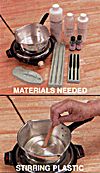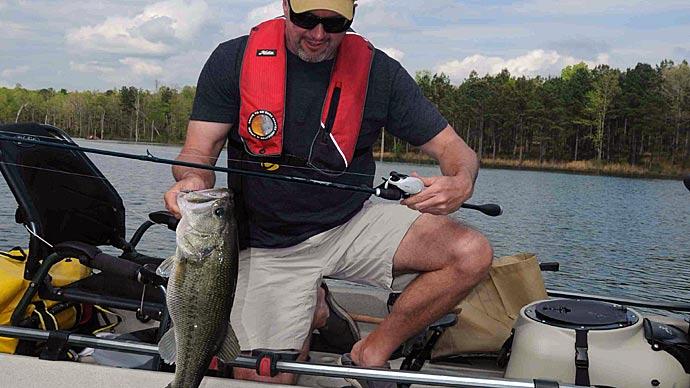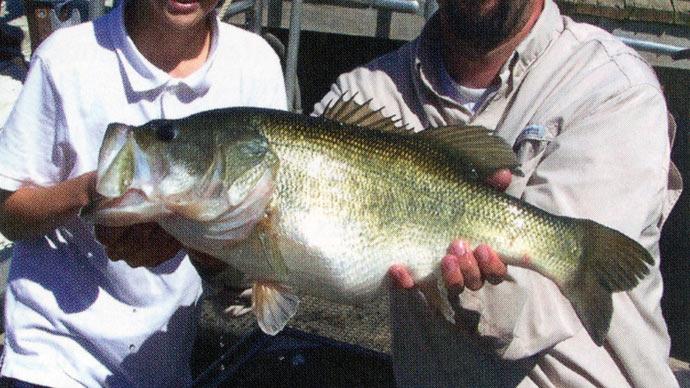| Estimated Expenses |
|
Molds - $8.00 eachPlastic - $35.00 per gallon(can be purchased in pint and quart sizes) Softener/Hardener - $8.00 per pint Colors - $3.00 per bottle(most anglers purchase more colors than they reed) Glitter - $3.50 per bottle Worm Oils - $3.00 per bottle Warming Pots - $8.00 each (Can get electric warming pots that are very helpful when pouring for about $60 each.) There are also beginner kits available for about $25.00 Cost of plastic worms in the store 10 pack = $.3.50 10 Hand Poured at home (after initial investment) = .60 Initial investment returned after approximately 530 worms. One gallon of plastic can make approximately 768 six-inch worms. |
| Where to find supplies |
|
Barlow's: (972) 231-5982 Sells many bait-making components. Lurecraft: Full-line supplier of hand-pour products. Call (800) 925-9088. Prescription Plastics: Based out of Kansas (913) 727-1225. Jann's Netcraft: In Ohio (419)868-8288 sells full line of materials. M-F Manufacturing: Retail/bulk pricing on materials, still sells resin molds, stocks RTV mold- making compound. Call (817) 281-9488 |
Let me start off by saying there are a lot of people with aspirations of making a lot of money hand pouring plastic worms, but unless you have a tremendous amount of capitol behind you, it's unrealistic to think you can get rich pouring worms. The cost of marketing, staffing, purchasing raw product, distribution and more puts success out of reach for the average starting entrepreneur. On the other hand, there can be a lot of fun and creativity in your leisure time pouring worms and you may even hit on a color combination or style that will put you ahead of others at your next tournament.
To begin with, you need to purchase some plastic, molds, colors, glitter, and a warming pot or two. The process is really quite simple and you're only limited by your imagination. As you learn more, you may even start creating your own molds.
I would suggest purchasing a gallon of plastic, for the average angler, this should be enough plastic to keep you in worms for a long time, unless of course your friends keep snatching them out of your tackle box. You can purchase the plastic for around $35. For about the same price you can also purchase hardener or softeners and experiment to see how stiff or soft you want your lures to be. But, instead of buying a gallon, purchase a quart or pint of each. They go a long way and you don't need as much.
You will also need a pouring or warming pan. These can be purchased for around $8 each.
Home pourers can purchase a large variety of molds from straight tail worms to crawdads for around $8 to $10 for a typical two-lure mold. Colors can be purchased for around $3 per bottle and there are a plethora of colors to choose from. One company has nearly 50 colors and by mixing colors you can invent thousands of new ones. The possibilities are limitless. There are glitters you can purchase for approximately $3.50 per color. Again, mixing colors can be great fun.
To begin, get your plastic, colors, molds, a spoon and your pouring pan ready. If you're heating the plastic on a stove (gas or electric), shake the plastic well and pour it into the pan. Be careful, you'll be surprised to know that an ounce of plastic will make approximately six average sized worms. Fill the pan too much and it will be more difficult to pour evenly. Heat the plastic slowly until the liquid thickens and becomes clear (this will happen at approximately 350 degrees Fahrenheit). Try to avoid overheating and scorching the plastic. At this point you can vary the toughness of the plastic with hardener or softener.
Now comes the color. It doesn't take much; one ounce is sufficient to color up to a gallon of plastic. Shake the color well and then add it to the plastic and stir it very well. Once you have achieved your desired color you can then add the glitter of desires. Again, don't go crazy, like the old Brylcream commercials used to say, 'a little dab'll do ya.' Fluorescent colors are best added when the plastic is cool.
|
Image

Image

|
Evenly pour the plastic into the molds. Fill the cavity of the mold until it almost crowns over. If you are making two-color worms, have both pots ready and pour the second color as soon as possible to assure a good bond to the first color.
Allow the worms to cool for three minutes or so and gently remove them from the mold and place them in a shallow pan of water to finish cooling the plastic. When the worms are cooled, remove them from the water and allow them to dry.
To help keep the worms from clinging to each other, it is recommended that you apply some type of worm oil into the bag. Worm oil can be purchased in a variety of scents and flavors costs about $3 per bottle. Just a few drops of worm oil will do the job.
Once you have mastered the process of mixing colors, getting the toughness to your liking and making clean pours, then you can move on to the next step, creating your own molds.
One way to begin making your own molds is to find various styles of worms and crawdads, or creature baits and piece them together to create something totally different. You can use a product called Worm-Weld and put the pieces together in the fashion you desire and then using plaster of Paris, you can make a shape of the new creation. Fiberglass resin is a better choice for durability but is also more expensive.
You can also carve and shape new shapes out of clay, wood, or a variety of materials to create a completely new bait unseen in today's fishing world. Just remember that they have to be thick enough to pull out of the mold without tearing.
Another great aspect of pouring your own worms is it provides you a way to recycle worms that have been worn and ripped. Don't toss them, put them away and then you can melt them down and reshape them into worms you can use again and again.
Always make sure you are in a well-ventilated room when you are melting and pouring the plastic.
While it's highly doubtful you will get rich pouring worms, you can save yourself some money in the long run, you can get highly creative, designing colors that others don't have in their tackle boxes and you may even create a lure that will become your fish catching secret. Of course, if you make one that is that good, don't be surprised if you find your closest fishing friends marauding your tackle boxes when your back is turned.
Reprinted with permission from Bass West Magazine




